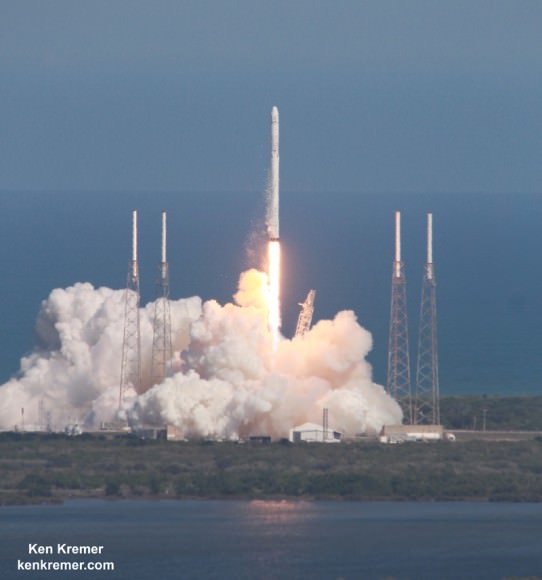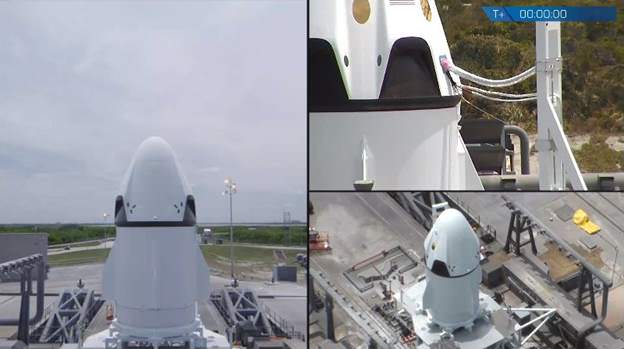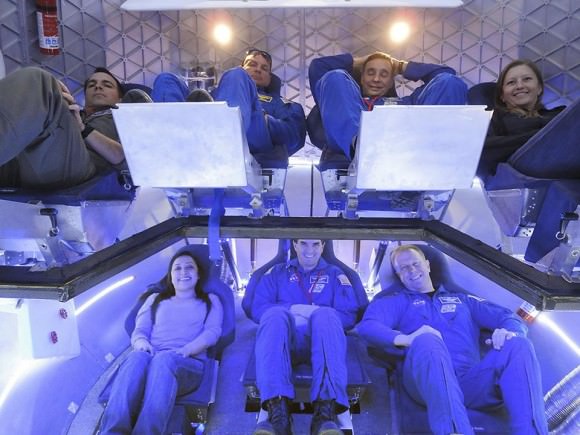The first critical test flight of SpaceX’s crewed Dragon that will soon launch American astronauts back to orbit and the International Space Station (ISS) from American soil is now less than two days away.
The test flight – called the Pad Abort Test – is slated for the early morning hours of Wednesday, May 6, if all goes well. The key facts and a timeline of the test events are outlined herein.
The test vehicle will reach roughly a mile in altitude (5000 feet, 1500 meters) and last only about 90 seconds in duration from beginning to end.
It constitutes a crucial first test of the crew capsule escape system that will save astronauts lives in a split second in the unlikely event of a catastrophic launch pad failure with the Falcon 9 rocket.
The May 6 pad abort test will be performed from the SpaceX Falcon 9 launch pad from a platform at Space Launch Complex 40 (SLC-40) at Cape Canaveral Air Force Station, Florida. The test will not include an actual Falcon 9 booster.
SpaceX has just released new images showing the Dragon crew capsule and trunk section being moved to the launch pad and being positioned atop the launch mount on SLC-40. See above and below. Together the Dragon assembly stands about 20 feet (5 meters) tall.
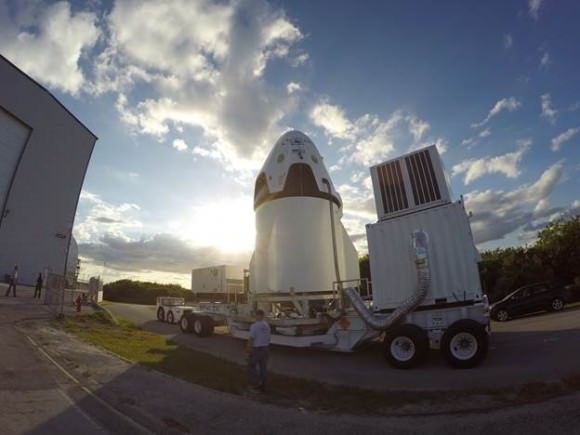
A test dummy is seated inside. And SpaceX now says the dummy is not named “Buster” despite an earlier announcement from the company.
“Buster the Dummy already works for a great show you may have heard of called MythBusters. Our dummy prefers to remain anonymous for the time being,” SpaceX said today.
So, only time will tell if that particular mission fact will ever be revealed.
You can watch the Pad Abort Test via a live webcast on NASA TV: http://www.nasa.gov/nasatv
The test window opens at 7 a.m. EDT May 6 and extends until 2:30 p.m. EDT into the afternoon.
The webcast will start about 20 minutes prior to the opening of the window. NASA will also provide periodic updates about the test at their online Commercial Crew Blog.
The current weather forecast predicts a 70% GO for favorable weather conditions during the lengthy test window.
Since the Pad Abort Test is specifically designed to be a development test, in order to learn crucial things about the performance of the escape system, it doesn’t have to be perfect to be valuable.
And delays due to technical issues are a very significant possibility.
“No matter what happens on test day, SpaceX is going to learn a lot,” said Jon Cowart, NASA’s partner manager for SpaceX at a May 1 media briefing at the Kennedy Space Center press site. “One test is worth a thousand good analyses.”
The test is critical for the timely development of the human rated Dragon that NASA is counting on to restore the US capability to launch astronauts from US soil abroad US rockets to the International Space Station (ISS) as early as 2017.
Here’s a graphic illustrating the May 6 SpaceX Pad Abort Test trajectory and sequence of planned events.
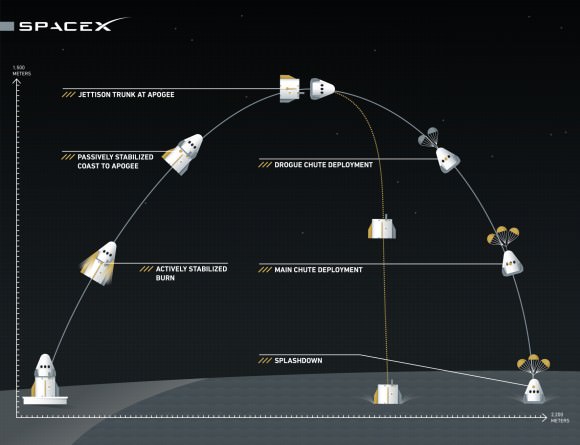
The Crew Dragon will accelerate to nearly 100 mph in barely one second. The test will last less than two minutes and the ship will travel over one mile in the first 20 seconds alone.
The pad abort demonstration will test the ability of a set of eight SuperDraco engines built into the side walls of the crew Dragon to pull the vehicle away from the launch pad in a split second in a simulated emergency to save the astronauts lives in the event of a real emergency.
The SuperDraco engines are located in four jet packs around the base. Each engine produces about 15,000 pounds of thrust pounds of axial thrust, for a combined total thrust of about 120,000 pounds, to carry astronauts to safety.
The eight SuperDraco’s will propel Dragon nearly 100 meters (328 ft) in 2 seconds, and more than half a kilometer (1/3 mi) in just over 5 seconds.
SpaceX likens the test to “an ejection seat for a fighter pilot, but instead of ejecting the pilot out of the spacecraft, the entire spacecraft is “ejected” away from the launch vehicle.”
Here’s a timeline of events from SpaceX:
T-0: The eight SuperDracos ignite simultaneously and reach maximum thrust, propelling the spacecraft off the pad.
T+.5s: After half a second of vertical flight, Crew Dragon pitches toward the ocean and continues its controlled burn. The SuperDraco engines throttle to control the trajectory based on real-time measurements from the vehicle’s sensors.
T+5s: The abort burn is terminated once all propellant is consumed and Dragon coasts for just over 15 seconds to its highest point about 1500 meters (.93 mi) above the launch pad.
T+21s: The trunk is jettisoned and the spacecraft begins a slow rotation with its heat shield pointed toward the ground again.
T+25s: Small parachutes, called drogues, are deployed first during a 4-6 second window following trunk separation.
T+35s: Once the drogue parachutes stabilize the vehicle, three main parachutes deploy and further slow the spacecraft before splashdown.
T+107s: Dragon splashes down in the Atlantic Ocean about 2200 meters (1.4 mi) downrange of the launch pad.
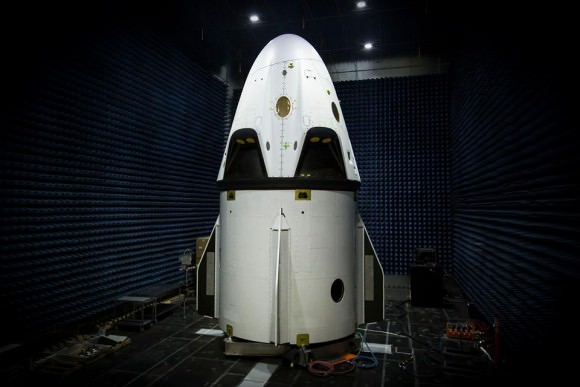
“This is what SpaceX was basically founded for, human spaceflight,” said Hans Koenigsmann, vice president of Mission Assurance with SpaceX.
“The pad abort is going to show that we’ve developed a revolutionary system for the safety of the astronauts, and this test is going to show how it works. It’s our first big test on the Crew Dragon.”
The pusher abort thrusters would propel the capsule and crew safely away from a failing Falcon 9 booster for a parachute assisted splashdown into the Ocean.
Koenigsmann notes that the SpaceX abort system provides for emergency escape all the way to orbit, unlike any prior escape system such as the conventional launch abort systems (LAS) mounted on top of the capsule.
The next Falcon 9 launch is slated for mid-June carrying the CRS-7 Dragon cargo ship on a resupply mission for NASA to the ISS. On April 14, a flawless Falcon 9 launch boosted the SpaceX CRS-6 Dragon to the ISS.
There was no attempt to soft land the Falcon 9 first stage during the most recent launch on April 27. Due to the heavy weight of the TurkmenÄlem52E/MonacoSat satellite there was not enough residual fuel for a landing attempt on SpaceX’s ocean going barge.
The next landing attempt is set for the CRS-7 mission.
Stay tuned here for Ken’s continuing Earth and planetary science and human spaceflight news.
